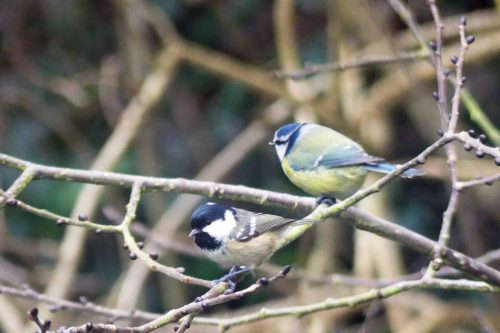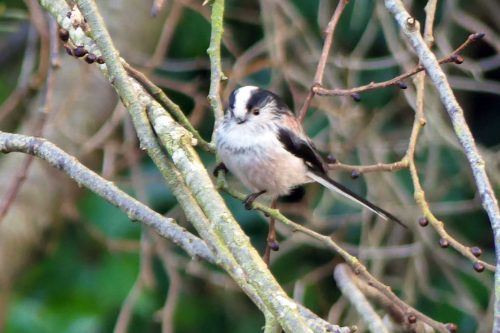Tags
bird behaviour, Blue tit, coal tit, foraging party of birds, goldcrest, Great Tit, long-tailed tit, mixed-species feeding flocks
Party season has arrived in the woodlands once more: the time when many of the more sociable and colourful of our smaller bird species temporarily put aside territorial squabbles, joining together to form a foraging cooperative and sweep through the trees en masse on unified hunts for prey. Variously referred to as ‘mixed-species feeding flocks’, ‘mixed hunting parties’ or less formally a ‘bird wave’, all describe the structure and purpose of these entities, but none can convey the vibrant energy that accompanies the birds on their whirlwind woodland tours.
September 26th
Bursting out from the woods, scattering into all parts of the Wych Elm like popping corn, excited Blue Tits immediately begin picking their way around the leafy twigs. There are a quite lot of them, too tricky to count accurately as they are so mobile. Blue Tits are numerous here and you rarely have to go far to see or hear one or more, so this could well be several local neighbouring families that have joined forces.
Seconds behind them dainty Long-tailed Tits appear, much gentler in their approach but then suddenly they’re everywhere, there must have been at least 12, maybe more.
I realise I’m being treated to a close-up, eye-level view of a travelling foraging party! I wish I could better convey the excitement and energy transmitted by these little birds that I felt even through my double-glazed kitchen window, it’s quite magical. I’d have been happy with just the Blue and Long-tailed Tits, but then there are Great Tits too; only three that I can see, one of which is a smartly feathered juvenile, similarly coloured to the adults that arrived with it but not as brightly yellow. Again, probably a family.
Birds continue to arrive, more Blue Tits, long-tailed Tits and then two Coal Tits, one of which perched on the end of a leafy twig and launched itself at the window, fluttering madly as it inspected its corners and joints for hiding insects or spiders.
Then just as I thought the last of the party members had arrived there are two Goldcrests. They are tricky to focus on as one seems to be chasing the other at speed through the tree branches. They may be our tiniest birds, but they’re quite feisty.
Most of the birds stay within the cover of the trees, but a few more adventurous ones venture over to check out parts of the building too. I already mentioned the Coal Tit coming to my window, but others were exploring the metal fire escape, which permanently in shade tends to have a coating of algae and lichens.
Blue and Long-tailed Tits tend to be the bravest, and where one bird ventures others follow to see what they’ve found, including a curious Goldcrest. Slightly below the level of my windows, I got to see the birds from some interesting angles,
These travelling foraging flocks typically have a core species around which others gather, typically Tits. Here I’m sure that Blue Tits are the central characters as well as being their most numerous members. They seem to lead or guide the flock and so are the first to arrive in a chosen foraging spot when they’re on the move. Other species accompanying or following them are known as attendants and they tend to join the foraging flock only when it enters their territory. Attendants may be other insectivores such as Nuthatches, Treecreepers and sometimes Woodpeckers.
The formation of mixed-species flocks is thought to benefit individuals by reducing the risk of predation; the more pairs of eyes that can spot predators such as Sparrowhawks and raise an alarm the better. On the same principal, it’s likely that their numbers and variety of feeding methods also increases foraging efficiency, the more pairs of eyes seeking insects the greater the chances of finding them. Differing sizes and methods of feeding allows the different species to forage in close proximity without conflict.




































